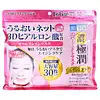What's inside
What's inside
 Key Ingredients
Key Ingredients

 Benefits
Benefits

 Concerns
Concerns

 Ingredients Side-by-side
Ingredients Side-by-side

Water
Skin ConditioningGlycerin
HumectantIsopentyldiol
HumectantHydrogenated Polydecene
EmollientAscorbyl Glucoside
AntioxidantFragaria Ananassa Fruit Extract
Skin ConditioningSphingomyelin
Skin ConditioningMentha Citrata Leaf Extract
AstringentMelaleuca Alternifolia Leaf Oil
AntioxidantHoney
HumectantSodium Hyaluronate
HumectantFragaria Chiloensis Fruit Juice
Skin ConditioningRubus Occidentalis Fruit Extract
AstringentSoy Acid
EmollientSoluble Collagen
HumectantMilk Extract
Skin ConditioningButylene Glycol
HumectantPEG-60 Hydrogenated Castor Oil
EmulsifyingAcrylates/C10-30 Alkyl Acrylate Crosspolymer
Emulsion StabilisingPolyglyceryl-10 Eicosanedioate/Tetradecanedioate
Skin ConditioningXanthan Gum
EmulsifyingPullulan
Sodium Hexametaphosphate
MaskingMenthol
MaskingPotassium Hydroxide
BufferingLactose
HumectantPhenoxyethanol
PreservativeEthylparaben
PreservativeMethylparaben
PreservativeParfum
MaskingWater, Glycerin, Isopentyldiol, Hydrogenated Polydecene, Ascorbyl Glucoside, Fragaria Ananassa Fruit Extract, Sphingomyelin, Mentha Citrata Leaf Extract, Melaleuca Alternifolia Leaf Oil, Honey, Sodium Hyaluronate, Fragaria Chiloensis Fruit Juice, Rubus Occidentalis Fruit Extract, Soy Acid, Soluble Collagen, Milk Extract, Butylene Glycol, PEG-60 Hydrogenated Castor Oil, Acrylates/C10-30 Alkyl Acrylate Crosspolymer, Polyglyceryl-10 Eicosanedioate/Tetradecanedioate, Xanthan Gum, Pullulan, Sodium Hexametaphosphate, Menthol, Potassium Hydroxide, Lactose, Phenoxyethanol, Ethylparaben, Methylparaben, Parfum
Water
Skin ConditioningGlycerin
HumectantPentylene Glycol
Skin ConditioningPPG-10 Methyl Glucose Ether
Skin ConditioningPEG-240/Hdi Copolymer Bis-Decyltetradeceth-20 Ether
StabilisingHyaluronic Acid/Polyglutamic Acid Crosspolymer
AntioxidantSodium Hyaluronate
HumectantHyaluronic Acid
HumectantHydrolyzed Hyaluronic Acid
HumectantDisodium EDTA
Polysorbate 60
EmulsifyingPhenoxyethanol
PreservativeResveratrol
AntioxidantGnetum Gnemon Seed Extract
Skin ConditioningDextrin
AbsorbentBeheneth-30
CleansingCitric Acid
BufferingAmmonium Acrylates Copolymer
Methylparaben
PreservativeWater, Glycerin, Pentylene Glycol, PPG-10 Methyl Glucose Ether, PEG-240/Hdi Copolymer Bis-Decyltetradeceth-20 Ether, Hyaluronic Acid/Polyglutamic Acid Crosspolymer, Sodium Hyaluronate, Hyaluronic Acid, Hydrolyzed Hyaluronic Acid, Disodium EDTA, Polysorbate 60, Phenoxyethanol, Resveratrol, Gnetum Gnemon Seed Extract, Dextrin, Beheneth-30, Citric Acid, Ammonium Acrylates Copolymer, Methylparaben
Ingredients Explained
These ingredients are found in both products.
Ingredients higher up in an ingredient list are typically present in a larger amount.
Glycerin is already naturally found in your skin. It helps moisturize and protect your skin.
A study from 2016 found glycerin to be more effective as a humectant than AHAs and hyaluronic acid.
As a humectant, it helps the skin stay hydrated by pulling moisture to your skin. The low molecular weight of glycerin allows it to pull moisture into the deeper layers of your skin.
Hydrated skin improves your skin barrier; Your skin barrier helps protect against irritants and bacteria.
Glycerin has also been found to have antimicrobial and antiviral properties. Due to these properties, glycerin is often used in wound and burn treatments.
In cosmetics, glycerin is usually derived from plants such as soybean or palm. However, it can also be sourced from animals, such as tallow or animal fat.
This ingredient is organic, colorless, odorless, and non-toxic.
Glycerin is the name for this ingredient in American English. British English uses Glycerol/Glycerine.
Learn more about GlycerinMethylparaben is a preservative and is a paraben. It is used to prevent the growth of fungus, mold, and other harmful bacteria. Parabens are chemicals used as preservatives in both cosmetics and food.
Methylparaben can be synthetically created. It can also be found naturally in some fruits, such as blueberries.
Oftentimes, Methylparaben is combined with other parabens to help increase the shelf life.
The safety of Methylparaben is currently being studied. While ongoing studies are looking into the safety of parabens, the results have been very mixed. Some studies have not found Methylparaben to be harmful.
Learn more about MethylparabenPhenoxyethanol is a preservative that has germicide, antimicrobial, and aromatic properties. Studies show that phenoxyethanol can prevent microbial growth. By itself, it has a scent that is similar to that of a rose.
It's often used in formulations along with Caprylyl Glycol to preserve the shelf life of products.
Sodium Hyaluronate is hyaluronic acid's salt form. It is commonly derived from the sodium salt of hyaluronic acid.
Like hyaluronic acid, it is great at holding water and acts as a humectant. This makes it a great skin hydrating ingredient.
Sodium Hyaluronate is naturally occurring in our bodies and is mostly found in eye fluid and joints.
These are some other common types of Hyaluronic Acid:
Learn more about Sodium HyaluronateWater. It's the most common cosmetic ingredient of all. You'll usually see it at the top of ingredient lists, meaning that it makes up the largest part of the product.
So why is it so popular? Water most often acts as a solvent - this means that it helps dissolve other ingredients into the formulation.
You'll also recognize water as that liquid we all need to stay alive. If you see this, drink a glass of water. Stay hydrated!
Learn more about Water